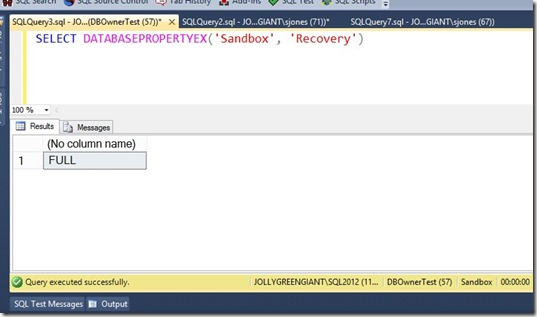Another post for me that is simple and hopefully serves as an example for people trying to get blogging as #SQLNewBloggers.
What can a user with the db_owner database role do? I assumed anything inside of the database (create/alter objects, assign permissions, back up the database, etc). However someone asked recently about whether someone could read database properties. I’d assume they can, but I needed to check.
I decided to start by creating a new login. I have lots on my test instance, but I went with just building a new one. I used the GUI to add [DBOwnerTest] because it’s quicker. I assigned a password, set a default database, and mapped this user to db_owner in a database.
I then opened a query window and changed the connection:
Now I could easily run a query for properties and see the results:
Note the connection at the bottom of the image above.
Here’s where it’s a little interesting. I disconnected Object Explorer and connected back as DBOwnerTest. I see this:
Looks normal. According to the BOL documentation for permissions, db_owner gets View Any Database as well as control over their own database. I can see the properties of the Sandbox database (where I’m db_owner).
But I can’t see properties of other databases.
I also see my login, but not the couple dozen others I have, other than sa. That’s curious, and perhaps not good. However this isn’t the place to delve into that.
I have the ability to query through databasepropertyex(), which I’ve documented in another post.
Certainly db_owner conveys lots of rights to the user, and certainly the ability to see some of the outside of the database container, such as the options and properties, as well as other databases.
Writing
This was based on a question I saw posted at SQLServerCentral. It took me about 5 minutes to set up a test login and query for information. I had to perform a few searches and try some queries. I spent a few minutes researching databasepropertyex(), which became another post.
All told, this was about a 15 minute post.
You can do this. Join the #SQLNewBlogger group and start documenting your career. You can see all my posts that fall into this area by looking through the SQLNewBlogger tag here.
References
Permissions of Fixed Database Roles – https://technet.microsoft.com/en-us/library/ms189612%28v=sql.90%29.aspx
Filed under: Blog Tagged: administation, sql server, SQLNewBlogger, syndicated
![]()









